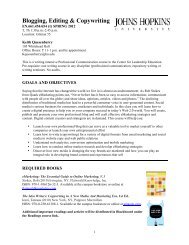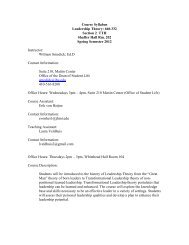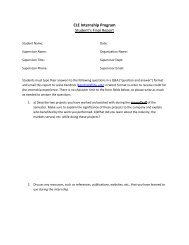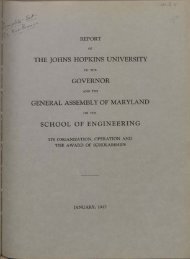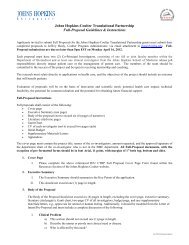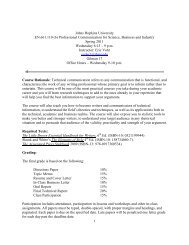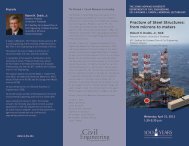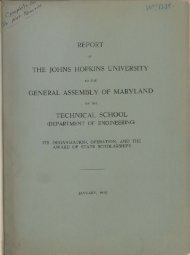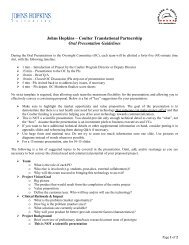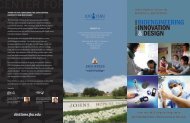Read More - Johns Hopkins University
Read More - Johns Hopkins University
Read More - Johns Hopkins University
Create successful ePaper yourself
Turn your PDF publications into a flip-book with our unique Google optimized e-Paper software.
A Century of<br />
Civil Engineering<br />
at the<br />
<strong>Johns</strong> <strong>Hopkins</strong><br />
<strong>University</strong>:<br />
1913-2013
A Century of Civil Engineering at the <strong>Johns</strong> <strong>Hopkins</strong> <strong>University</strong>:<br />
1913-2013<br />
In his 1876 inaugural address as president of <strong>Johns</strong> <strong>Hopkins</strong> <strong>University</strong>,<br />
Daniel Coit Gilman cited the need, in well-populated areas, for civic or<br />
municipal engineers.<br />
Indeed, in the decades that followed, the country experienced a transformation<br />
from an agrarian to an industrial society. The waves of immigrants, rise of a<br />
prosperous middle class, and mass production of the automobile all taxed the<br />
existing infrastructure. The need for a large cadre of college-trained engineers<br />
who could address immediately the technological requirements of a growing<br />
nation was all too evident.<br />
By 1910, the State of Maryland was losing nearly 300 young men each year to<br />
engineering schools in other states, and it felt keenly the lack of a local training<br />
program that would supply an ongoing source of qualified engineers. That<br />
same year, perhaps fueled by public sentiment, the state offered to finance<br />
the addition of an engineering school at <strong>Johns</strong> <strong>Hopkins</strong> to coincide with<br />
establishment of the university’s Homewood campus. <strong>University</strong> trustees agreed,<br />
and a bill passed in 1912 that provided 129 full scholarships to the new school<br />
for Maryland residents.<br />
The move met with hearty approval not just in Maryland, but across the nation.<br />
Those who sent letters of support included Woodrow Wilson, a university<br />
graduate and then governor of New Jersey, who commented, “The <strong>University</strong>, the<br />
State, and the country are to be most heartily congratulated on the action of the<br />
Legislature. Maryland will thus quicken and advance the industrial development<br />
of the nation.”<br />
The university’s new Department of Engineering was first known briefly as the<br />
School of Technology, and the Committee on the School of Technology visited<br />
faculty at the principal engineering schools on the East Coast to discern what<br />
we now call “best practices” in instruction, curriculum, and laboratory work.<br />
Committee members also conferred with a number of prominent consulting<br />
engineers, examined entrance requirements at engineering schools, and even<br />
visited 27 county high schools to determine the qualifications of the graduates.<br />
As a result, the university trustees and professors charged with establishing<br />
the engineering program at <strong>Johns</strong> <strong>Hopkins</strong> saw an opportunity to create an<br />
entity that would not only be a worthy addition to an already distinguished<br />
university, but one that would improve the methods of engineering instruction.<br />
They elected to offer instruction in three disciplines: electrical engineering,<br />
mechanical engineering, and civil engineering.
The Early Years<br />
In 1913, Harvard alumnus Charles J. Tilden arrived from the <strong>University</strong> of<br />
Michigan to serve as the first professor of civil engineering; instruction in the<br />
discipline began in the 1913-1914 academic year. Of the first 60 students in<br />
the Department of Engineering, three chose to study civil engineering.<br />
Professor Tilden taught three undergraduate courses:<br />
Engineering Drawing; Civil Engineering I: Structural<br />
Mechanics, Theory of the Strength of Materials, and<br />
Elements of Structural Design; and Surveying, a one-month<br />
summer course. He devoted much of his time to evaluating<br />
and procuring surveying equipment and machines<br />
for the materials testing laboratory at Homewood. He<br />
also collected enough relevant books, magazines, and<br />
photographs to establish a library.<br />
The Mechanical and Electrical Building (renamed Maryland Hall in 1931) was<br />
the first home of civil engineering. The State of Maryland’s 1912 Technical<br />
School Bill also provided funds for the construction of a building specifically for<br />
the discipline. Sited directly across from Maryland Hall, the Civil Engineering<br />
Building opened its doors in 1916, at a cost of $150,000. The new building<br />
featured three laboratories in the basement, administrative and classroom space<br />
on the first floor (even room for a museum), three large drafting rooms on the<br />
second floor, and a single large room on the third floor for free-hand drawing<br />
and blueprinting.
In 1915, university president Frank <strong>Johns</strong>on Goodnow requested that the<br />
fledgling engineering program contribute to preparations for a possible war<br />
effort by instituting a series of “Night Courses for Technical Workers.” These<br />
courses provided immediate instruction to Baltimore artisans and technicians<br />
whose services would be needed quickly should the United States join the<br />
“Great War.” Thus civil engineering was an important component of the very<br />
first part-time program at <strong>Johns</strong> <strong>Hopkins</strong>. When the university formed the<br />
nation’s first Reserve Officer Training Corps (ROTC), Professors Tilden and<br />
J.H. Bringhurst taught courses in military field engineering, map reading, and<br />
military topography.<br />
By the 1916-1917 academic year, the civil engineering program had developed<br />
a four-year course of study and had begun its first research project, an<br />
investigation of cement mortars and concretes, which could be made from<br />
materials in Maryland.<br />
A Growing Department<br />
In 1919, the Department of Engineering became the School of Engineering,<br />
and civil engineering became a stand-alone department. That same year,<br />
Professor Tilden resigned to accept the chair of engineering mechanics at<br />
Yale.<br />
During his tenure at <strong>Johns</strong> <strong>Hopkins</strong>, Tilden wrote an article justifying the<br />
institution of an engineering school in the university, pointing out that an<br />
engineer must possess qualities such as creativity, which are best developed<br />
in the atmosphere of a university. In his article, Tilden also commented that<br />
in the <strong>Johns</strong> <strong>Hopkins</strong> program of civil engineering, 24 percent of the degree<br />
requirements fell into the categories of the humanities and social sciences, more<br />
than at any other school in the United States.<br />
Professor John H. Gregory became the second chair<br />
and directed the new department until 1930. He<br />
added practical experience to the civil engineering<br />
curriculum, sending students on inspection trips to<br />
municipal structures, such as water filtration and<br />
purification works and bridges, and to industrial<br />
and power plants. The students also presented a<br />
seminar in their final year. From extant copies of<br />
those presentations, we know that the senior class<br />
ranged in size from 10 to 19 during the 1920s.
Through the efforts of Prof. Gregory, the Department organized the student<br />
chapter of the American Society of Civil Engineers (ASCE) in 1921. The goal of<br />
the chapter – the 13th to be established in the country – was to “promote closer<br />
relationships between students and civil engineering and to assist in furthering<br />
original investigations.”<br />
In 1930, J. Trueman Thompson succeeded Prof. Gregory as Department chair.<br />
A member of the engineering class of 1917, Prof. Thompson was an expert on<br />
roadways and took charge of building a new campus road system at Homewood.<br />
The Civil Engineering Building was renamed Latrobe Hall in 1931 to honor<br />
Benjamin Henry Latrobe, Jr., the 19th century engineer best known for his<br />
railroad bridges. In 1937, Abel Wolman joined the Department to help expand<br />
its program in sanitary engineering. With joint appointments in civil engineering<br />
and the School of Hygiene and Public Health, Prof. Wolman developed a<br />
graduate-level program that would achieve full status as the Department of<br />
Sanitary Engineering in 1946.
In addition to fulfillng their academic and research duties, civil engineering<br />
faculty participated in other university activities. In 1938, for instance,<br />
Prof. Thompson and Professor Thomas Hubbard agreed to supervise the<br />
transformation of what was considered a sub-standard playing field into the<br />
university’s first baseball diamond, located on what is now Decker Quad. There<br />
is little doubt that the brand-new field was a factor in the beginning of a winning<br />
streak for the Blue Jays baseball team during the next several years.<br />
As another world conflict threatened to involve the United States, university<br />
president Isaiah Bowman and others surmised that victory would depend on<br />
technology. The School of Engineering joined with the U.S. government and<br />
other institutions in a comprehensive instruction program that would be known<br />
as the Engineering, Science, Management, War Training Program. Several civil<br />
engineering faculty were instructors in the program; Professors Thomas Comber<br />
and Thomas Hubbard taught courses that included Engineering Fundamentals<br />
for Women. Other faculty served as consultants to state and federal agencies.<br />
For example, Prof. Thompson was director of the Highway Traffic Advisory<br />
Committee of the War Department. Civil engineering laboratories were<br />
repurposed to address research topics targeted for the war effort.<br />
As might be expected, World War II curtailed student field trips, as<br />
undergraduates and graduates took advantage of accelerated programs that<br />
freed them for the war effort more quickly. The ASCE student chapter remained<br />
active, hosting the national convention in 1941 and the annual student chapter<br />
dance in 1942. The field trips resumed in 1949, this time sponsored by the<br />
ASCE student chapter rather than the Department. The war had significant<br />
consequences for the department: enrollment increased, graduate education<br />
grew in importance, and demand increased for civil engineers at all levels.
A Time of Change<br />
The Department continued to take pride in the well-rounded education<br />
it offered. Its course requirements allowed students a good number<br />
of electives, both within the Department and in other departments,<br />
particularly the humanities and social sciences. The proportion of nonengineering<br />
classes gradually declined, but the emphasis on a liberal education<br />
was renewed after World War II; in the decades of the 1950s and 1960s other<br />
universities followed <strong>Hopkins</strong>’ example in this regard.<br />
In the 1950s, a number of significant<br />
changes across the engineering school<br />
signaled a shift from “practical”<br />
engineering instruction to one<br />
focused on fundamentals of the<br />
discipline. In 1960, a proposal was<br />
approved to merge the Departments<br />
of Civil Engineering, Mechanics, and<br />
Aeronautics into a single Department<br />
of Mechanics with George S. Benton<br />
as chair. The faculty of the three<br />
departments recognized that aspects<br />
of their disciplines had become<br />
obsolete, and that their common interests in the broad field of mechanics –<br />
fluid mechanics, solid mechanics, and several areas of classical physics – might<br />
flourish in an integrated environment.<br />
In 1966, the School of Engineering merged with the Faculty of Philosophy<br />
to form the School of Arts and Sciences, diminishing the presence of civil<br />
engineering even further. Engineering alumni were understandably upset, and<br />
within a decade, it became clear to all that the merger had been a mistake.<br />
Through the efforts of many, including civil engineers and university trustees<br />
Willard Hackerman ’38 and F. Pierce Linaweaver ’55’65, the university made the<br />
commitment to create an academic center of excellence in the new engineering<br />
school. Mr. Hackerman was instrumental in securing a gift from the estate of<br />
G.W.C. Whiting, co-founder of the Whiting-Turner Contracting Company, to<br />
fund (and name) the new school.<br />
Even though the engineering school was re-established in 1979, the civil<br />
engineering department was not yet back to full strength. Rather, it combined<br />
with materials science to form the Department of Materials Science and<br />
Engineering/Civil Engineering. This made sense, according to the late Robert B.<br />
Pond, Sr., materials science and engineering professor, because “so much of civil<br />
engineering is materials.”
A Renewed Department<br />
It was the intent of the Whiting School to<br />
reconstitute the civil engineering department, and<br />
Dean V. David VandeLinde hired Northwestern<br />
<strong>University</strong> Professor Ross Corotis in 1981 to rebuild<br />
and lead the program. Prof. Corotis recruited faculty<br />
and even purchased the necessary furniture, including<br />
the acquisition of the now-infamous dental chair from<br />
the state’s surplus furniture warehouse.<br />
On July 1, 1983, civil engineering was recognized<br />
officially as a full department in the engineering school. The Department’s fall<br />
1983 newsletter, The Bridge, announced with pride, “The Department of Civil<br />
Engineering exists again!” The celebratory party included champagne and hors<br />
d’oeuvres on toothpicks stuck in a concrete cylinder. The new departmental<br />
status also meant a move back to Latrobe Hall, and the beginning of muchneeded<br />
renovations to the building.<br />
In spring 1985, the Department held the first Richard J. Carroll Memorial<br />
Lectureship in Civil Engineering to honor an alumnus and one of Baltimore’s<br />
leading structural engineers. The lectures have brought a number of renowned<br />
scholars to the Department to interact with students and faculty, including<br />
William F. Baker, structural and engineering partner, Skidmore, Owings & Merrill,<br />
and Professor Leslie E. Robertson, one of the structural engineers for the World<br />
Trade Center, the Bank of China Tower, and the Puerta de Europa.<br />
In fall 1985, the Department dedicated the new 4,000-square-foot laboratory<br />
wing in Latrobe Hall, with facilities for undergraduate laboratories, graduate<br />
soil mechanics, structural dynamics, and structural testing. It also hosted a<br />
conference on “Civil Engineering Education and Research.”<br />
In 1986, the Department created the Civil Engineering Advisory Committee,<br />
consisting of alumni and other prominent engineers. The group’s objectives were<br />
to act as a liaison with industry and government, to bring external guidance<br />
and advice on aspects of education and research, and to assist in long-range<br />
planning and identify support for the Department’s objectives. During this time,<br />
the Department applied for and received ABET accreditation, with the visiting<br />
committee commenting on the innovative features of the materials evaluation<br />
laboratory and the engineering systems design courses.
As the Department grew, so too did the faculty’s research efforts. In 1989, for<br />
example, active, multi-years grants awarded by corporations and government<br />
agencies totaled $1,693,886, and the faculty published 41 journal articles. By<br />
1996, grants had increased to $2,804,646, with 81 journal articles. Faculty also<br />
hosted a number of national conferences, including the National Conference on<br />
Wind Engineering and the ASCE Engineering Mechanics Division Conference.<br />
The ASCE student chapter participated regularly in local and national concrete<br />
canoe and steel bridge competitions. The chapter also continued to act as<br />
a connector between civil engineering students and industry professionals,<br />
providing assistance in preparing for job interviews and in securing<br />
employment. Students volunteered for Habitat for Humanity, using their<br />
practical skills to help renovate rowhouses in Baltimore City.<br />
When not hard at work in the classroom and laboratory, graduate and<br />
undergraduate students combined their expertise in other areas to represent<br />
the Department in extracurricular activities. In 1997, the Civilians softball<br />
team posted an impressive record of 11 wins and two losses. That same year,<br />
the Civilians volleyball team won the regular season competition as well as the<br />
university tournament.<br />
Through the years, Department faculty have<br />
received national and international acclaim for their<br />
achievements in the field. To select only one example<br />
from the many awards that have been conferred,<br />
four faculty have been elected to membership in the<br />
prestigious National Academy of Engineering: Professor<br />
Robert Scanlan (1987), Professor Bruce Ellingwood<br />
(2001), Prof. Ross Corotis (2002), and Professor Robert<br />
Dalrymple (2006).
In 2004, Professor Nicholas Jones, a former<br />
member of the civil engineering department and<br />
its chair from 1999 to 2002, returned to <strong>Johns</strong><br />
<strong>Hopkins</strong> as the Whiting School’s seventh dean.<br />
It is fitting that he is the first to hold the title of<br />
Benjamin T. Rome Dean. Mr. Rome graduated<br />
with a bachelor’s degree in civil engineering<br />
from <strong>Johns</strong> <strong>Hopkins</strong> in 1925 and went on to<br />
lead the Hyman Construction Company, now<br />
known as Clark Construction Company.<br />
Civil Engineering at <strong>Johns</strong> <strong>Hopkins</strong>: 2012-2013<br />
Today, the Department is home to a vibrant group of faculty – 10<br />
primary and five lecturers, researchers, and part-time faculty –<br />
whose research interests fall into three major areas: structures,<br />
systems, and mechanics of materials. While the graduate program has<br />
grown in the past several years to more than 50 students, undergraduate<br />
enrollment remains stable at approximately 60 students. The ASCE student<br />
chapter continues to host a variety of activities, such as the Student Night<br />
and Career Fair with the ASCE Maryland Section
During the past several years, the Department has placed an emphasis on<br />
increased collaboration among research areas and disciplines. For example,<br />
civil engineering faculty hold leadership roles in the university’s new<br />
Systems Institute and the <strong>Hopkins</strong> Extreme Materials Institute. Faculty also<br />
have developed interdisciplinary courses, such as Professor Ben Schafer’s<br />
Perspectives on the Evolution of Structures, a popular offering that draws<br />
interest from students in the Krieger School of Arts and Sciences and the<br />
Maryland Institute College of Art.<br />
Current research facilities include the Coastal Engineering Laboratory, the<br />
Thin-Walled Structures Laboratory, the Smart Structures and Hybrid Testing<br />
Laboratory, the Geotechnical Engineering Laboratory, the Computational<br />
Mechanics Research Laboratory (CMRL) and the Computing Cluster.<br />
The Department is thriving and is well represented by the more than 1,200<br />
living alumni, who lead successful and distinguished careers in civil engineering<br />
as well as in business, law, and medicine. It continues to exemplify the spirit<br />
of inquiry and discovery as evoked by Frank <strong>Johns</strong>on Goodnow in his 1915<br />
inaugural address as the second president of <strong>Johns</strong> <strong>Hopkins</strong>:<br />
“There are great advantages to be derived from the association of technical<br />
schools with the university, particularly where research and investigation, with<br />
the idea of enlarging the sum of human knowledge, are recognized as a part of<br />
the university’s work.”<br />
Building on its achievements and the lessons learned during the past 100<br />
years, the Department of Civil Engineering looks forward to its next century<br />
of teaching, research, and service.<br />
This brief history of the Department of Civil Engineering is far from complete. We<br />
hope that those who know the Department best – its students, alumni, and faculty –<br />
will share their insights and memories to expand upon this beginning effort. During<br />
its centennial year, the Department also is building a comprehensive list of chairs,<br />
professors, and notable alumni. To be part of the living history of the Department of<br />
Civil Engineering, please send submissions to civil@jhu.edu.
www.ce.jhu.edu



